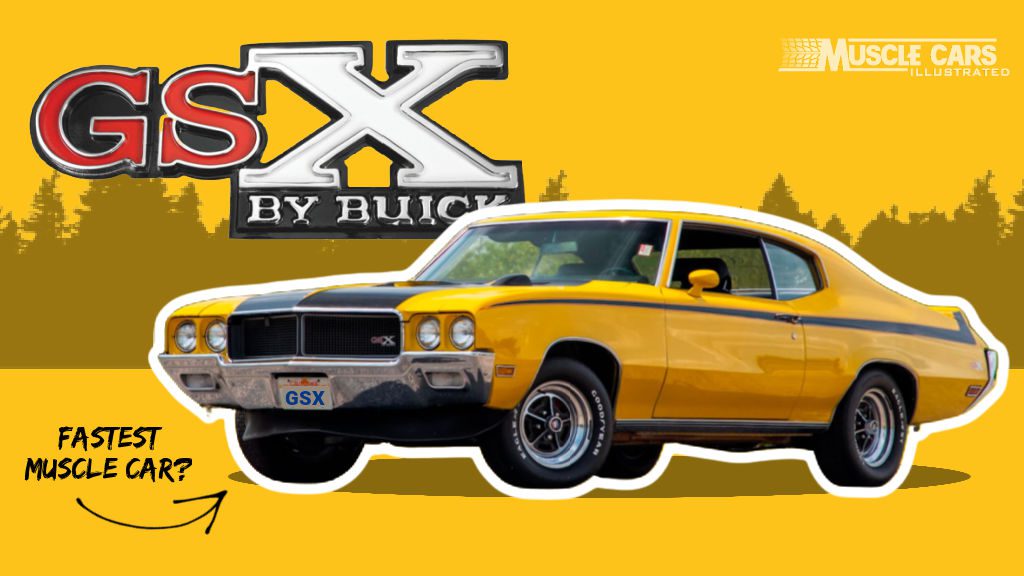
The Buick GSX was arguably the most radical muscle car Buick ever produced.
It had everything a muscle car buyer could want, including eye-catching paint colors, stunning graphics, front and rear spoilers, and breakneck speed.
While it seemed built for mass appeal, the GSX was a true limited-edition muscle car.
While Buick had produced the Buick Gran Sport “GS” since 1965, it wasn’t known as one of the revolutionary American muscle cars by any stretch of the imagination until 1970.
In fact, just the opposite.
With a subdued color palette and all the creature comforts, this “Gentleman’s Muscle Car” wasn’t at the top of the list for young buyers looking for vibrant (and affordable) muscle.
While the price didn’t come down, Buick found a way to increase its youthful image by introducing the Buick GSX, which added eye-popping paint, stripes, and a rear spoiler.
Buick didn’t stop at radical good looks, either.
Originally, every GSX also came standard with a torquey 455 CID V-8. However, starting in 1971, one could be had with a 350 CID V-8—the same found in the base Buick Skylark GS.
Let’s break down each model year for the Buick GSX to uncover their similarities and differences, shall we?
Table of Contents
Buick GSX History
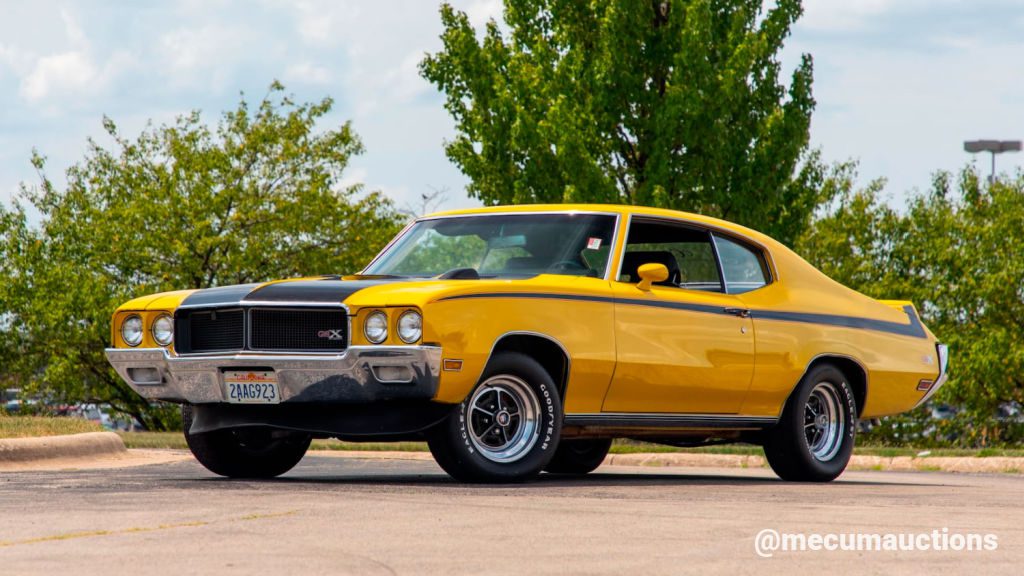
It is no secret that 1970 Muscle Cars were the pinnacle of the muscle car era’s performance, handling, and appearance. It was an all-out battle between GM, Ford, and Chrysler.
General Motors lifted its 400 cubic inch limit on the compact and intermediate models to compete with Chrysler and Ford’s previously established big block powerplants.
Chrysler had the 426 Hemi and 440 starting in 1966; Ford had the 428 Cobra Jet beginning in 1968, and the Boss 429 in 1969.
Not to be outdone by the Pontiac GTO Judge, Oldsmobile 442 W-30, and the Chevrolet Chevelle SS454, Buick dropped the mic with the introduction of the 1970 Buick GSX.
The GSX was Buick’s ultimate Muscle Car, combining an appearance, handling, and performance package that was remarkably on point, given its reputation as GM’s conservative motor division.
While it had all the right stuff, the GSX only lasted three years and never really helped Buick ignite sales of the GS as intended.
1970 Buick GSX
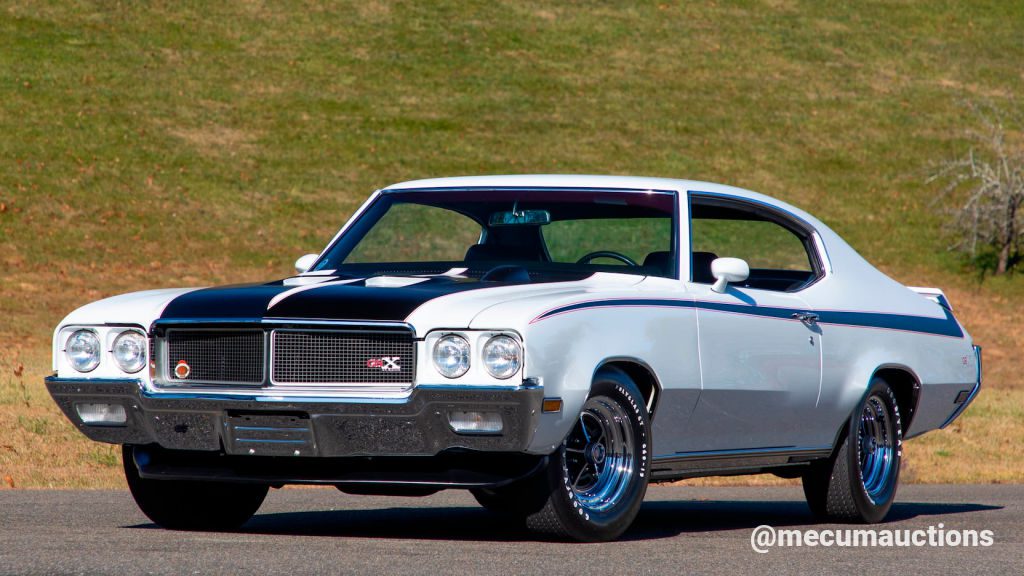
In its debut year, the 1970 Buick GSX jumped into the pool’s deep end in classic cannonball fashion—making a splash to help kick start sluggish sales of the base Buick GS.
As a show of confidence, Buick printed a colorful 4-page sales brochure that declared, “Buick GSX…Something to Believe In.”
As it turns out, neither Buick nor buyers seemed to believe in the GSX as time passed.
While the dedicated sales brochure helped spark 678 sales, it paled in comparison to the 1970 Pontiac GTO Judge, which sold 3,797 units, and the Oldsmobile 4-4-2 W-30, which sold 3,100 units.
Buick’s print ad stated, “Buick GSX: A limited edition.” They were either trying to create exclusivity to stimulate demand or always planned it to be a limited production run.
Either way, 1970 was the peak year for GSX production, and it fulfilled its destiny as a limited-edition muscle car.
The Buick GSX package added $1,195.87 to the $3,283 Buick GS base pricing, which puts it in a price range that is out of reach for most young buyers.
Appearance
Of the 678 Buick GSXs made in 1970, 187 were in Apollo White, with the remaining 491 in Saturn Yellow. All were hardtops.
You could get any interior you wanted, so long as it was a black bucket seat interior. All came with a Rallye clock and operating gauges. A floor-mounted shifter was mandatory.
Appearance Package Highlights
- GSX emblems and decals
- Front spoiler
- Rear spoiler
- Black matte hood stripes with red pinstriping
- Black bodyside/rear spoiler striping with red pinstriping
- Color-keyed Sport Mirrors
- Color-keyed headlight bezels
- Hood tach
- 5-Spoke chrome wheels
- Super Wide Oval White Billboard Lettered Tires
- Full-length console
- Padded steering wheel
- Black bucket seat interior
Handling
The GSX handling package was called the “Rallye ride package” and included a heavy-duty suspension full of road-handling goodies.
- Ride-tuned front and rear gas shocks
- Front and rear sway bars
- Firm Ride Control arms and bushings
- Firm Ride Control Coil Springs (Front & Rear)
- Power front disc brakes
Performance
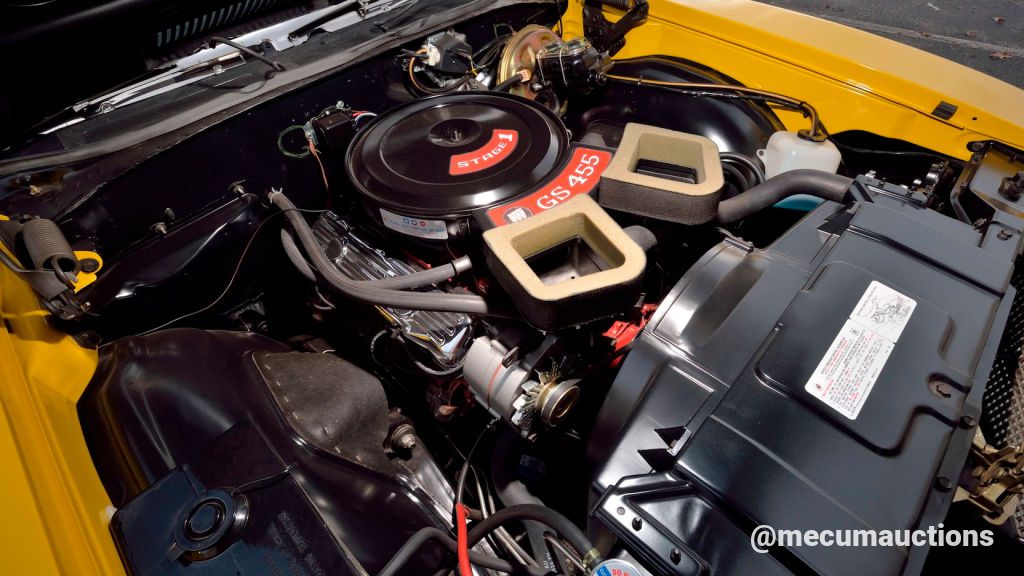
The GSX performance package included two options: a 455 CID V-8 with 350 hp/510 lb-ft of torque and a 455 CID V-8 Stage 1 with 360 hp/510 lb-ft of torque.
Both engines came standard with heavy-duty cooling.
Like all Buick GS’s, every GSX had functional cold air induction that forced air into the engine via dual open scoops from the hood.
The 3.42 gear posi-traction rear axle was standard.
In the July 1970 issue of Car Craft magazine, a 1970 Buick GSX catapulted to a 13.66-second ET at 100.2 miles per hour.
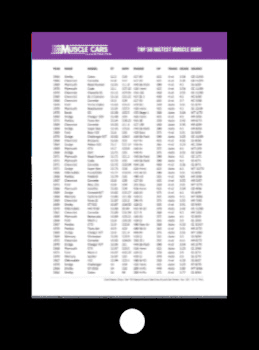
Get The Top 50 Fastest Muscle Cars chart. Includes year, model, engine, 1/4 mile times, and more—absolutely free!
1971 Buick GSX
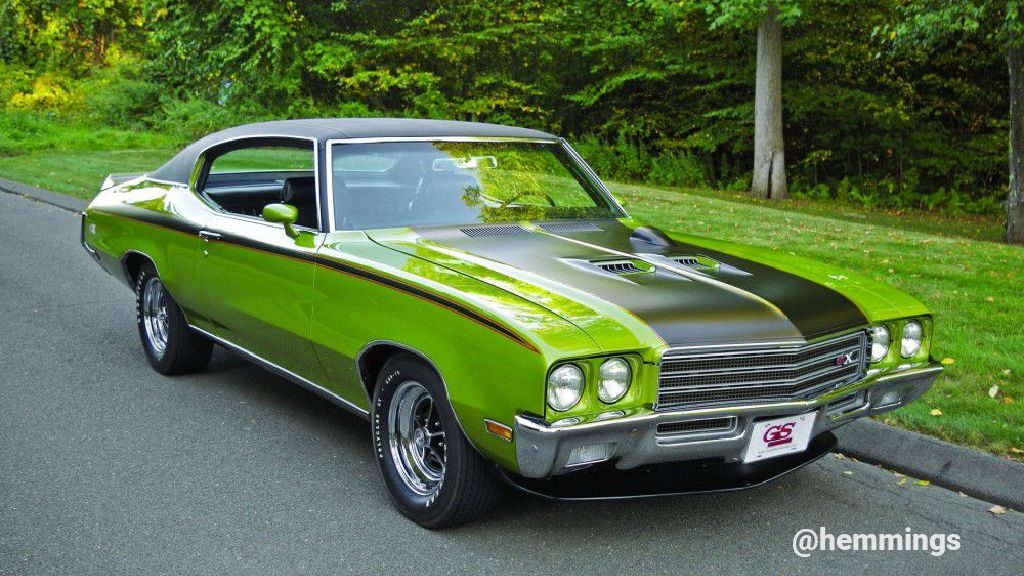
While Buick carried over the GSX in 1971, they seemed to lose confidence in it, dedicating only one paragraph to the sales brochure. And sales suffered from it, with an 86% decrease for this model year.
Only 124 GSXs rolled off the assembly line in 1971. The GSX was barely a blip on the radar, a drop in the bucket compared to the 9,046 Buick GSs that sold that year.
The GSX limped into the 1971 model year, adding paint colors and a new fuel-efficient engine option to try and bolster sales.
Appearance
There were nine paint colors to choose from on the 1971 Buick GSX. However, Apollo White and Saturn Yellow didn’t return.
The GSX was now available in Arctic White, Bittersweet Mist, Black, Cortex Gold, Fire Red, Limemist Green, Platinum Mist, Stratomist Blue, and the rare Verdemist Green.
All colors received black matte stripes with a red pinstripe except for black-painted vehicles. Buick painted the hood and body stripes gold with a white pinstripe when painted black.
Much to the chagrin of Buick enthusiasts, the 8,000 rpm hood tach was the same one used on the 1970 Pontiac GTO Judge. It was 100% Pontiac, not Buick.
You no longer had to choose a black interior with bucket seats. Other colors, including white and saddle, became available, and bucket seats were no longer mandatory, so a bench seat option was introduced.
A vinyl top was also optional, available in beige, black, brown, and white for the first time.
Appearance Package Highlights
- GSX emblems and decals
- Front spoiler
- Rear spoiler
- Black matte hood stripes with red pinstriping*
- Black bodyside/rear spoiler striping with red pinstriping*
- Color-keyed Sport Mirrors
- Hood tach
- 5-Spoke wheels
- G60 Wide Ovals
* Except when painted black. Buick then painted the stripes gold with a white pinstripe.
Handling
The heavy-duty suspension saw minor changes in 1971, primarily to the braking system on the newly introduced 350 engine option.
- Heavy-duty front and rear gas shocks
- Front and rear sway bars
- Firm ride control arms and bushings
- Coil springs (front and rear)
- Power front disc brakes (Mandatory on 455’s only)
Performance
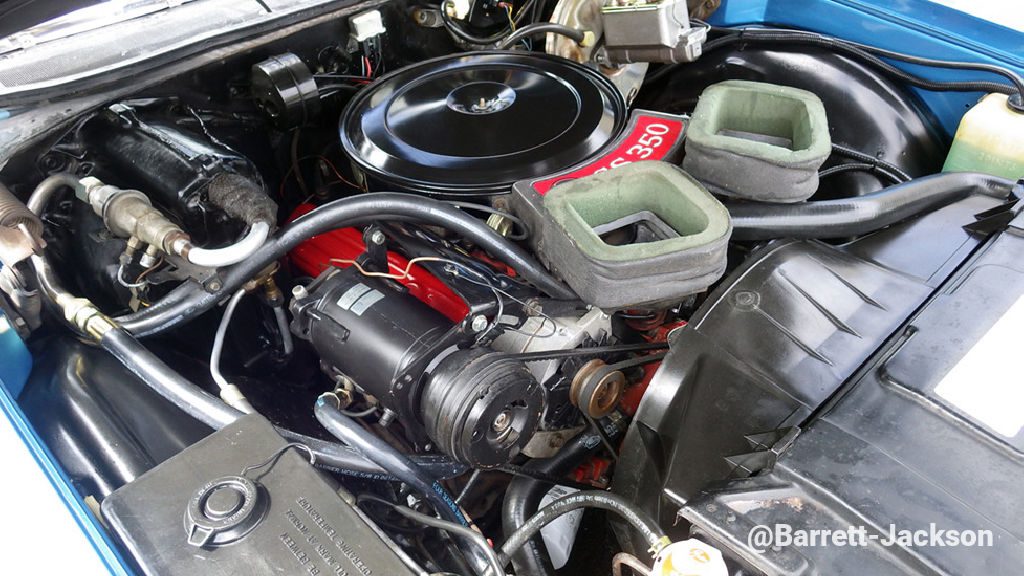
The engine options included a 455 CID V-8 with 315-hp/450 lb-ft or a 455 CID V-8 Stage 1 with 345-hp/460 lb-ft. Additionally, Buick added an economical 350 CID V-8 with 260 hp/360 lb-ft.
A column-shifted 3-speed manual was standard on the 350 GSX. Big blocks retained the choice of a 4-speed manual shifter or 3-speed automatic on the floor.
Cold air induction continued to be standard on all GSX and GS models.
Regardless of engine displacement, I couldn’t find a GSX quarter-mile time recorded in any automotive journals that year.
However, in the January 1971 issue of the 1971 Supercars Annual, a 1971 Buick GS Stage 1 ran a 14.50 quarter-mile, traveling 101 miles per hour.
Buick produced 124 GSXs in 1971. All were hardtops.
The 3.42 gear posi-traction rear axle became optional. The 3.08:1 was now standard.
1972 Buick GSX
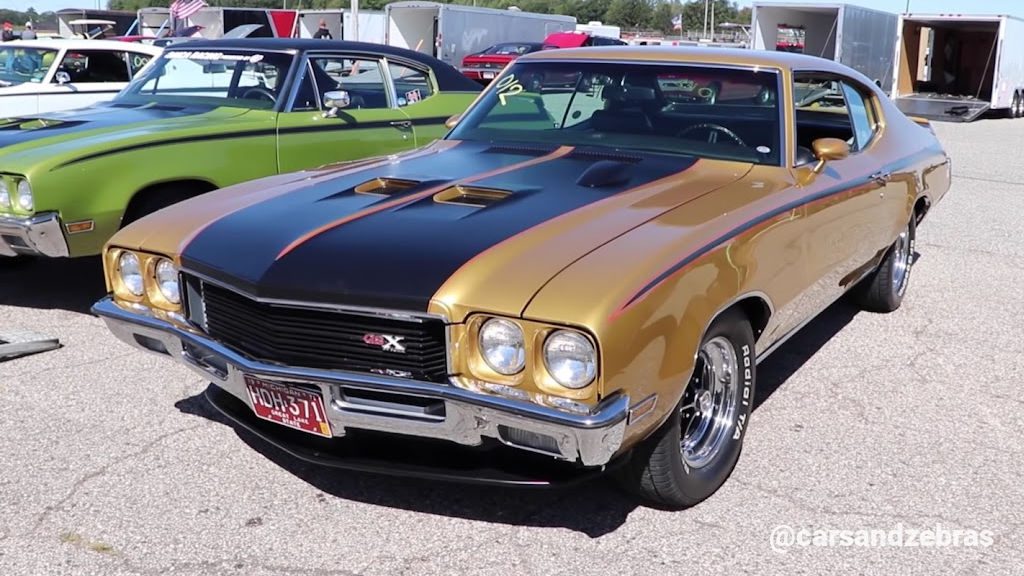
After a 64.5% decrease in units in 1971, one would think that Buick would either halt the production of the 1972 Buick GSX or double down on advertising and marketing to bring more attention to it.
However, Buick chose to do neither.
Once again, sales suffered because Buick didn’t alert prospective buyers that the hardtop GSX was available in its sale brochures, dealer marketing, or advertisements.
Marketing 101 states that if you want to sell more of something, you must make customers aware that it exists. Buick failed to advertise the GSX to customers, so sales plummeted to 44 units in 1972.
However, it wasn’t all Buick’s fault. The automotive industry was moving to lower-compression engines in 1972, so high-performance muscle cars were on their way out.
In addition, General Motors experienced labor strikes that year that slowed the production of vehicles and prevented it from releasing its new body style, which was ultimately released in 1973.
Everything became a carryover in 1972, with minor changes to help limp along until the strikes were over. The Buick GSX was no exception.
In the end, all these factors helped end the most radical muscle car Buick ever produced. 1972 would become the final year of the high-performance GSX.
Appearance
The 1972 Buick GSX was available in twelve colors, including four carry-over colors from 1971 and eight new color introductions—ambitious given it was never marketed properly.
Carry-over colors included Arctic White, Cortez Gold, Fire Red, and Stratomist Blue.
New colors included Burnished Copper, Flame Orange, Heritage Green, Hunter Green, Sandalwood, Seamist Green, Silver Mist, and Sunburst Yellow.
With 44 units spread across 12 paint color options, roughly four examples are made in each color. 18 of the 44 were produced in unique one-off combinations when the vinyl top color is factored in.
As for the interior, the majority had either white or black bucket seats, while three cars had unique interior choices—one each of black notchback, white notchback, and saddle bench seats.
Once standard equipment, the hood tach, front spoiler, 5-spoke wheels, and G60 tires were now optional.
Appearance Package Highlights
- GSX emblems and decals
- Rear spoiler
- Black matte hood stripes with red pinstriping
- Black bodyside/rear spoiler striping with red pinstriping
- Color-keyed Sport Mirrors
- Front Spoiler (Now optional)
- Hood tach (Now optional)
- 5-Spoke wheels (Now optional)
- G60 Wide Ovals (Now optional)
Handling
The suspension saw a few changes in 1972 compared to previous years.
- Heavy-duty springs
- Heavy-duty shocks (Front and rear)
- Front sway bar
- Coil springs (front and rear)
- Rallye Firm Ride and Handling (Optional)
- Hydraulic Shocks (Optional)
- Rear sway bar (Optional)
- Power Front Disc Brakes (Standard on 455s, Optional on 350s)
Performance
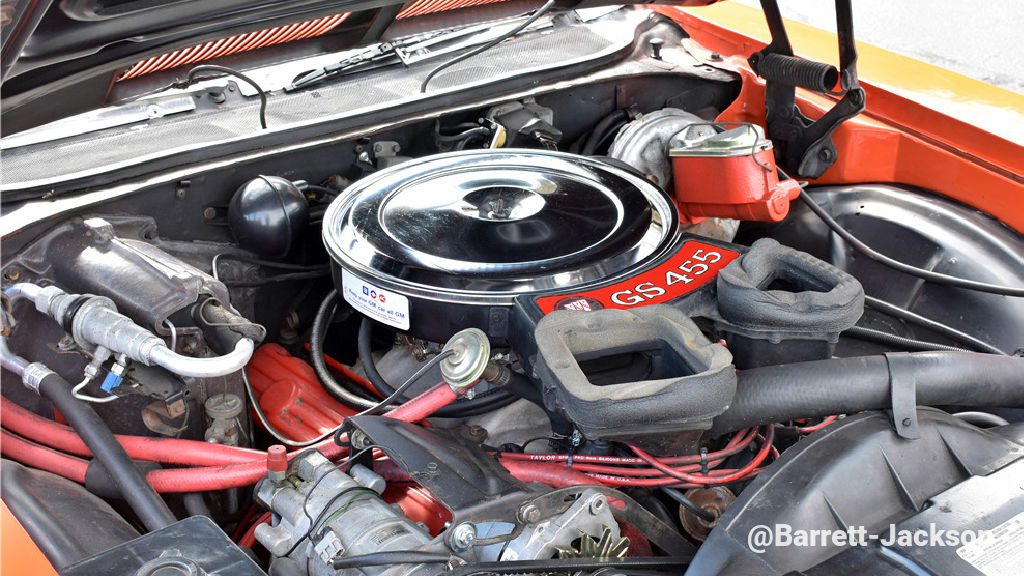
Engine options remained unchanged, including a 350 CID V-8 with 195 hp, a 455 CID V-8 with 250 hp/375 lb-ft, and a 455 CID V-8 Stage 1 with 270 hp/390 lb-ft.
A 3-speed stick was standard with all 350s, and a 4-speed stick or TH-350 automatic was optional.
With the big-block 455s, one could choose between a 4-speed or a TH-400 automatic.
Unfortunately, there wasn’t any historical record of a 1972 Buick GSX quarter-mile test in any magazines.
However, in the June 1972 issue of Motor Trend Magazine, a 1972 Buick GS 455 ran a 14.10-second quarter-mile, traveling 97 miles per hour.
Of the three engines available, 16 came with a 350 engine, 4 with the base 455, and 24 with the mighty Stage 1 455.
Only four of the 44 had a 4-speed shifter, while the remaining 40 had an automatic transmission. If you’re going for ultra rarity, a 4-speed version is the one to own.
Buick GSX Related Questions
What does GSX stand for Buick?
GSX stands for “Gran Sport Experimental” and was one of the most radical muscle cars you could own during the muscle car era.
How many 1970 Buick GSX were built?
Buick produced a total of 846 GSXs between 1970 and 1972. Buick produced 678 in 1970, 124 in 1971, and only 44 in 1972.
How Fast is a 1970 Buick GSX?
In the July 1970 issue of Car Craft magazine, a 1970 Buick GSX ran a 13.66 ET at 100.2 miles per hour.
However, a Buick GS (the base model of a GSX) recorded a 13.38 ET traveling at 105.5 miles per hour In the January 1970 issue of Motor Trend magazine—which used the same engine as the GSX.
How much horsepower does a 1970 Buick GSX have?
The base 455 CID V-8 produced 350 horsepower, while the 455 Stage 1 option had 360 horsepower. Both numbers, particularly for the 455 Stage 1, were underrated for insurance purposes.
Is the 1970 Buick GSX the fastest muscle car?
Motor Trend magazine stated the 1970 Buick GS 455 Stage 1 was “The Quickest American Production Car” in 1970, not the GSX, a fact that is often misquoted in articles.
That said, it still wasn’t one of the top five fastest. As stated in our article “Top 10 Fastest Muscle Cars of 1970,” seven other vehicles, including a Stage 1 Buick GS, were ahead of it that year.
Take Our Poll!
"*" indicates required fields

Ryan Wheaton
Ryan has owned muscle cars since 1986 and currently owns a 1972 Dodge Charger Rallye. He combines passion and experience to create engaging content for fellow muscle car enthusiasts. In 2018, he founded Muscle Cars Illustrated, authoring hundreds of articles on tips, history, and trends in the muscle car industry. He attends national car shows, auctions, and museums to stay current with the latest developments in the muscle car industry.Comments
Comments are closed.


Good article, saw my first GSX on a big turn table in plant 36, the old engine plant in Flint, Michigan. I was 11 years old. It was the Saturn Yellow one. We went to the open house every year because my Grandfather worked there as machine set up. I was so taken with it they couldn’t drag me away from it.
Hi Jim,
I just bought one yesterday and even though it’s 52 years old I had that same feeling..